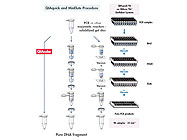
Qiagen’s QIAquick DNA clean up kits are marketed in three different forms. These are the PCR purification kit, the nucleotide removal kit and the gel extraction kit. The principle behind all three is very similar. I have personally used two of the three: the PCR purification kit and the gel extraction kit. I favor the PCR purification kit simply because it saves excising bands from agarose gels to purify the DNA fragment and yields more DNA than from gel extraction. In some cases the gel extraction kit is more applicable, for example if a PCR reaction generates multiple amplification products or the original source of DNA to be purified is from a different experiment which may contain contaminants that this kit can not effectively remove. In the case that a PCR reaction has resulted in one clear DNA band identified by agarose gel electrophoresis, using the QIAquick PCR purification kit is my favored approach.
I use this kit when I want to either clone or sequence a DNA fragment that I’ve been able to amplify by PCR. This is a fairly common application in the lab for us, so the consistency and robustness of this kit are important to me. The manufacturers state that the kit is able to purify single- or double-stranded DNA fragments ranging from 100 bp to 10 kb in length. Many plasmids and vectors are bigger than this, which is why PCR products from plasmids can also be purified.
The principle of this technology is simple. The DNA of interest is bound to a special membrane, the remaining sample is washed out and then the DNA of interest is eluted. DNA binding occurs at a pH of 7.5 and the binding buffer has a pH indicator added to it, which makes it possible to adjust the pH for maximum DNA recovery. The binding column itself is a silica membrane which binds DNA under specific salt concentrations. These are maintained during the successive wash steps. DNA elution can then be performed in either Tris buffer or sterile water. I prefer sterile water because the purified DNA sample can be directly used in a variety of downstream applications which may be sensitive to the salt in Tris buffers. DNA is less stable in sterile water, however; therefore it is important to store it at -20°C. I would recommend this kit to users who are routinely doing PCR and generating samples which they need to clone or sequence.
Research Associate
Dept of Biological Sciences
Royal Holloway University of London